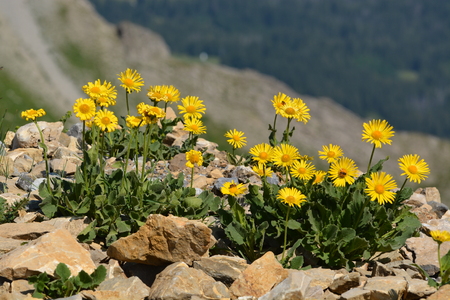Arnica
 Arnica /ˈɑːrnɪkə/ is a genus of perennial, herbaceous plants in the sunflower family (Asteraceae). The genus name Arnica may be derived from the Greek arni, "lamb", in reference to the plants' soft, hairy leaves. Arnica is also known by the names mountain tobacco and, confusingly, leopard's bane and wolfsbane—two names that it shares with the entirely unrelated genus Aconitum.
Arnica /ˈɑːrnɪkə/ is a genus of perennial, herbaceous plants in the sunflower family (Asteraceae). The genus name Arnica may be derived from the Greek arni, "lamb", in reference to the plants' soft, hairy leaves. Arnica is also known by the names mountain tobacco and, confusingly, leopard's bane and wolfsbane—two names that it shares with the entirely unrelated genus Aconitum.
This circumboreal and montane (subalpine) genus occurs mostly in the temperate regions of western North America, with a few species native to the Arctic regions of northern Eurasia and North America.[2]
Arnica species are used as food plants by the larvae of some Lepidoptera species, including Bucculatrix arnicella.
Arnica was previously classified in the tribe Senecioneae because it has a flower or pappus of fine bristles.
Arnica is the basis of a homeopathic remedy promoted for aiding bruise recovery.
Arnica plants have a deep-rooted, erect stem that is usually unbranched. Their downy opposite leaves are borne towards the apex of the stem. The ovoid, leathery basal leaves are arranged in a rosette.[3]
They show large yellow or orange flowers, 6–8 cm (2–3 in) wide with 10–15 cm (4–6 in) long ray florets and numerous disc florets. The phyllaries (a bract under the flowerhead) has long spreading hairs. Each phyllary is associated with a ray floret. Species of Arnica, with an involucre (a circle of bracts arranged surrounding the flower head) arranged in two rows, have only their outer phyllaries associated with ray florets. The flowers have a slight aromatic smell.[3]
The seedlike fruit has a pappus of plumose, white or pale tan bristles. The entire plant has a strong and distinct pine-sage odor when the leaves of mature plants are rubbed or bruised.[3]
The species Arnica montana, native to Europe, has long been used in folk medicine, but there is no clinical evidence for its homeopathic use as an effective therapy.[4]
Arnica montana contains the toxin helenalin, which can be poisonous if large amounts of the plant are eaten, and contact with the plant can also cause skin irritation.[5] Medical preparations can cause skin irritation if applied topically, and adverse effects include headache and drowsiness if ingested. High doses can have severe adverse effects including death.[6]
Accepted species:[7]